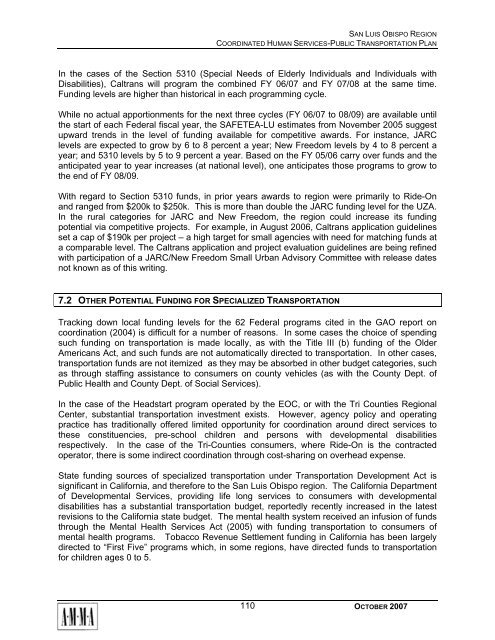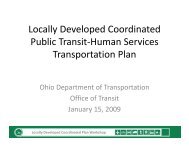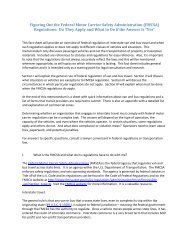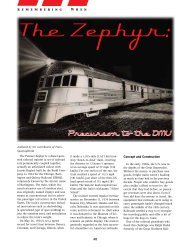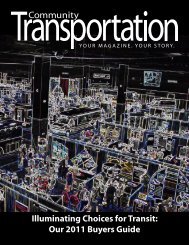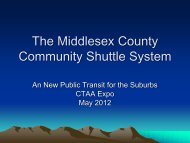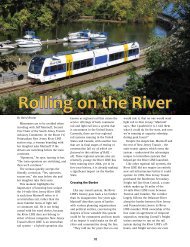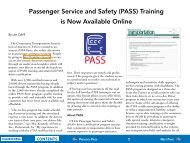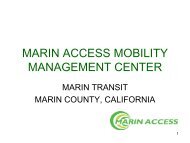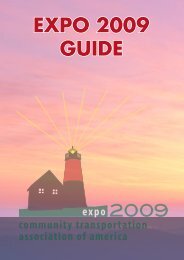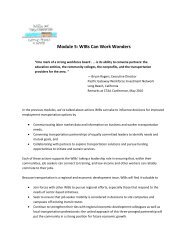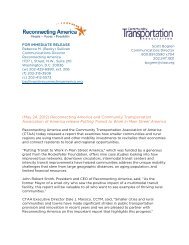San Luis Obispo - Caltrans - State of California
San Luis Obispo - Caltrans - State of California
San Luis Obispo - Caltrans - State of California
You also want an ePaper? Increase the reach of your titles
YUMPU automatically turns print PDFs into web optimized ePapers that Google loves.
SAN LUIS OBISPO REGION<br />
COORDINATED HUMAN SERVICES-PUBLIC TRANSPORTATION PLAN<br />
In the cases <strong>of</strong> the Section 5310 (Special Needs <strong>of</strong> Elderly Individuals and Individuals with<br />
Disabilities), <strong>Caltrans</strong> will program the combined FY 06/07 and FY 07/08 at the same time.<br />
Funding levels are higher than historical in each programming cycle.<br />
While no actual apportionments for the next three cycles (FY 06/07 to 08/09) are available until<br />
the start <strong>of</strong> each Federal fiscal year, the SAFETEA-LU estimates from November 2005 suggest<br />
upward trends in the level <strong>of</strong> funding available for competitive awards. For instance, JARC<br />
levels are expected to grow by 6 to 8 percent a year; New Freedom levels by 4 to 8 percent a<br />
year; and 5310 levels by 5 to 9 percent a year. Based on the FY 05/06 carry over funds and the<br />
anticipated year to year increases (at national level), one anticipates those programs to grow to<br />
the end <strong>of</strong> FY 08/09.<br />
With regard to Section 5310 funds, in prior years awards to region were primarily to Ride-On<br />
and ranged from $200k to $250k. This is more than double the JARC funding level for the UZA.<br />
In the rural categories for JARC and New Freedom, the region could increase its funding<br />
potential via competitive projects. For example, in August 2006, <strong>Caltrans</strong> application guidelines<br />
set a cap <strong>of</strong> $190k per project – a high target for small agencies with need for matching funds at<br />
a comparable level. The <strong>Caltrans</strong> application and project evaluation guidelines are being refined<br />
with participation <strong>of</strong> a JARC/New Freedom Small Urban Advisory Committee with release dates<br />
not known as <strong>of</strong> this writing.<br />
7.2 OTHER POTENTIAL FUNDING FOR SPECIALIZED TRANSPORTATION<br />
Tracking down local funding levels for the 62 Federal programs cited in the GAO report on<br />
coordination (2004) is difficult for a number <strong>of</strong> reasons. In some cases the choice <strong>of</strong> spending<br />
such funding on transportation is made locally, as with the Title III (b) funding <strong>of</strong> the Older<br />
Americans Act, and such funds are not automatically directed to transportation. In other cases,<br />
transportation funds are not itemized as they may be absorbed in other budget categories, such<br />
as through staffing assistance to consumers on county vehicles (as with the County Dept. <strong>of</strong><br />
Public Health and County Dept. <strong>of</strong> Social Services).<br />
In the case <strong>of</strong> the Headstart program operated by the EOC, or with the Tri Counties Regional<br />
Center, substantial transportation investment exists. However, agency policy and operating<br />
practice has traditionally <strong>of</strong>fered limited opportunity for coordination around direct services to<br />
these constituencies, pre-school children and persons with developmental disabilities<br />
respectively. In the case <strong>of</strong> the Tri-Counties consumers, where Ride-On is the contracted<br />
operator, there is some indirect coordination through cost-sharing on overhead expense.<br />
<strong>State</strong> funding sources <strong>of</strong> specialized transportation under Transportation Development Act is<br />
significant in <strong>California</strong>, and therefore to the <strong>San</strong> <strong>Luis</strong> <strong>Obispo</strong> region. The <strong>California</strong> Department<br />
<strong>of</strong> Developmental Services, providing life long services to consumers with developmental<br />
disabilities has a substantial transportation budget, reportedly recently increased in the latest<br />
revisions to the <strong>California</strong> state budget. The mental health system received an infusion <strong>of</strong> funds<br />
through the Mental Health Services Act (2005) with funding transportation to consumers <strong>of</strong><br />
mental health programs. Tobacco Revenue Settlement funding in <strong>California</strong> has been largely<br />
directed to “First Five” programs which, in some regions, have directed funds to transportation<br />
for children ages 0 to 5.<br />
110<br />
OCTOBER 2007


